Watermelons are such a delightful and refreshing summer staple – it seems almost too good to be true that we can grow these fruits in our own backyards.
Of course, there are so many incredible varieties to choose from, it can be very difficult to know which ones to pick.
I’ve made a list of 25 of the best watermelon cultivars – including picnic, icebox, personal-sized, and seedless varieties, as well as some with unexpected flesh colors.
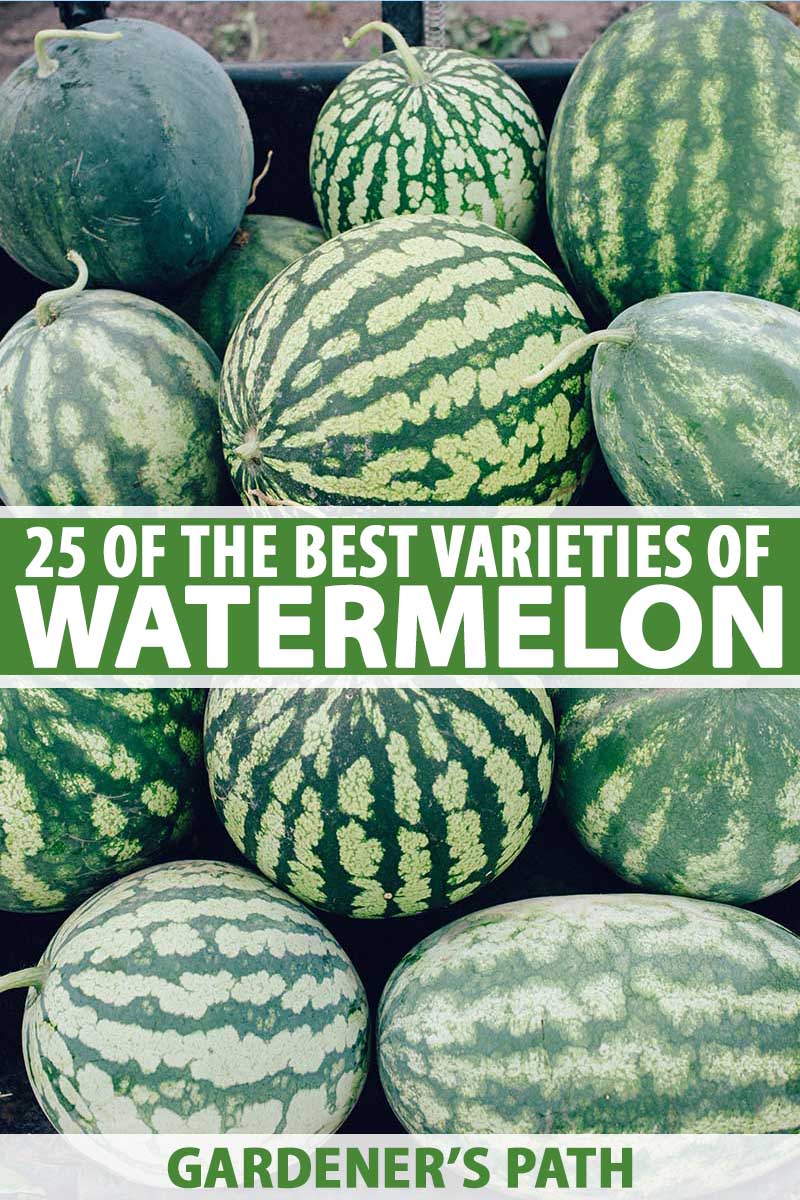
We link to vendors to help you find relevant products. If you buy from one of our links, we may earn a commission.
Whether you’re in the mood for seed-spitting contests, juicy giants, sweet yellow babies, or something else entirely, I can practically guarantee that you’ll find exactly the watermelon variety you’re looking for in this roundup.
Before I get into the specifics of these 25 varieties, here’s a peek at the ones that made it onto my list:
25 of the Best Watermelon Varieties
Picnic
Picnic type cultivars are what most of us think of when we think of watermelon.
Whether oblong or round, the fruits weigh at least 15 pounds, but often more – enough to feed a small crowd during a summer gathering.
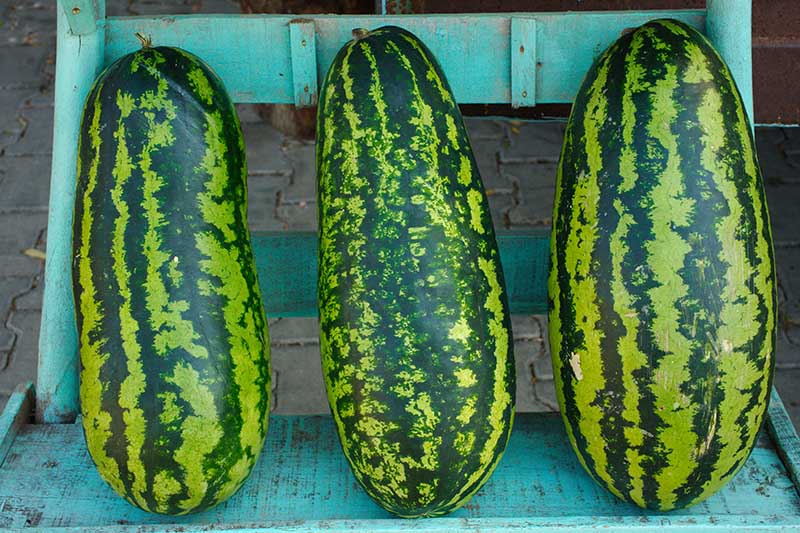
The big fruits on these cultivars mean they tend to require more growing time than others before they’ll be ready to harvest.
If you have a long growing season you can sow the seeds directly into your garden soil.
But if, like me, your summer gardening fun is typically foreshortened by early autumn frosts, you’ll probably need to start picnic type watermelons indoors and transplant them out to your garden after your last spring frost.
Read more about how to determine whether you should start seeds indoors or plant them directly in the garden.
Ready to dig into all the sweet and juicy details? Alright, grab your napkin and let’s go!
1. Allsweet
‘Allsweet’ has the classic look of a picnic watermelon variety. With good disease resistance, it’s well-suited to long growing seasons.
This cultivar produces large oblong fruits weighing in at 25-30 pounds each, with dark and light green striped skin.
With sweet, bright red, firm flesh, fruits will reach 17-19 inches long and seven inches in diameter at maturity. Seeds are dark brown.
Also called ‘All Sweet’ this is an open-pollinated variety, so you can save the seeds from this year’s crop to grow next year’s melons.
Plants have a height of 15-24 inches, with vines spreading to 72-96 inches, and are resistant to fusarium wilt and anthracnose.
‘Allsweet’ will be ready to harvest in 90-104 days after sowing.
Packets of 100 certified organic seeds are available to purchase from Burpee.
2. Charleston Gray
‘Charleston Gray’ is a distinguished heirloom variety producing large cylindrical fruit that have uniform greenish-gray skin.
Also sometimes referred to as ‘Charleston Grey,’ this open-pollinated picnic cultivar’s sweet red flesh is crisp and fiberless. The fruits’ hard rinds make them good keepers.
These often top out at 28 to 35 pounds each when they’re ready to harvest, so you better be ready to eat some watermelon this summer if you choose this type!
Plants reach a height of 15-24 inches and should be thinned to 36 inches apart, to allow for a spread of 72 to 96 inches.
This cultivar is resistant to fusarium wilt and anthracnose as well as sunburn. Expect a harvest in 85 days.
‘Charleston Gray’ is available to purchase in packets of 50 seeds from Burpee.
3. Crimson Sweet
‘Crimson Sweet’ is an open-pollinated picnic-type heirloom variety that remains many gardeners’ top pick, and for good reason – it’s delicious, productive, and disease resistant.
This large, round cultivar weighs in at around 25-35 pounds at harvest, and it has a light green rind with dark green stripes.
This watermelon’s flesh is dark red and firm, with a fine texture and small dark seeds.
‘Crimson Sweet’ has a high sugar content, contributing to its delicious sweet flavor. Fruits have thick rinds, which hold up well to handling.
Plants are vigorous, reaching heights of 15-24 inches with a spread of six to eight feet, and are resistant to anthracnose and fusarium wilt.
You’ll be harvesting these sweet juicy melons in 80 days.
Ready to join the legions of ‘Crimson Sweet’ fans? Packets of 100 seeds can be purchased from Burpee.
4. Georgia Rattlesnake
‘Georgia Rattlesnake’ bears large, oblong fruits with light green skin and dark green stripes – bringing rattlesnake skin to mind to some gardeners.
This picnic-type heirloom variety can reach 24 inches long and averages 30 pounds at maturity, with bright pink sweet flesh, and a thin rind.
And it’s open-pollinated, so save those seeds for planting next year.
Expect 90 days to maturity, with a height of 15-24 inches and a spread of 72-96 inches.
You’ll find ‘Georgia Rattlesnake’ seed packets for purchase in an assortment of sizes from Eden Brothers.
5. Klondike Blue Ribbon Striped
‘Klondike Blue Ribbon Striped’ is an open-pollinated heirloom variety that has been a garden favorite since the early 1900s, beloved for its delicious sweet flesh.
This picnic cultivar produces oblong melons that will max out at 20-30 pounds.
Fruits have thin but tough rinds with alternating light and dark green stripes. Flesh is bright crimson, delicious, crisp, and its high sugar content makes it super sweet.
‘Klondike Blue Ribbon Striped’
Plants are resistant to fusarium wilt, anthracnose, and sunburn. Although the rinds of these fruits are thin, they hold up well to handling.
‘Klondike Blue Ribbon Striped’ will be ready to harvest in 80-90 days.
You’ll find seeds available for purchase in an assortment of packet sizes at True Leaf Market.
6. Sweet Princess
‘Sweet Princess’ is an open-pollinated, disease-resistant heirloom watermelon bearing oblong fruits that reach 20-30 pounds.
Fruits have thin but tough rinds that are light green with dark green marbling. Flesh is pink, crisp, and sweet, with a fine texture and very small tan seeds.
These pink-fleshed picnic watermelons grow to 15 inches long by eight inches wide.
‘Sweet Princess’ has good resistance to fusarium wilt and anthracnose, and will be ready to harvest in 85-95 days.
You’ll find seeds available for purchase in a selection of package sizes at Eden Brothers.
Icebox
Moving on from picnic to icebox type watermelons, we are moving down in size. Icebox types grow to six to 15 pounds at full ripeness and can generally fit in the fridge, aka the “icebox.”
If you’re concerned about not being able to finish a whole picnic watermelon once you cut it open, these make a good alternative.
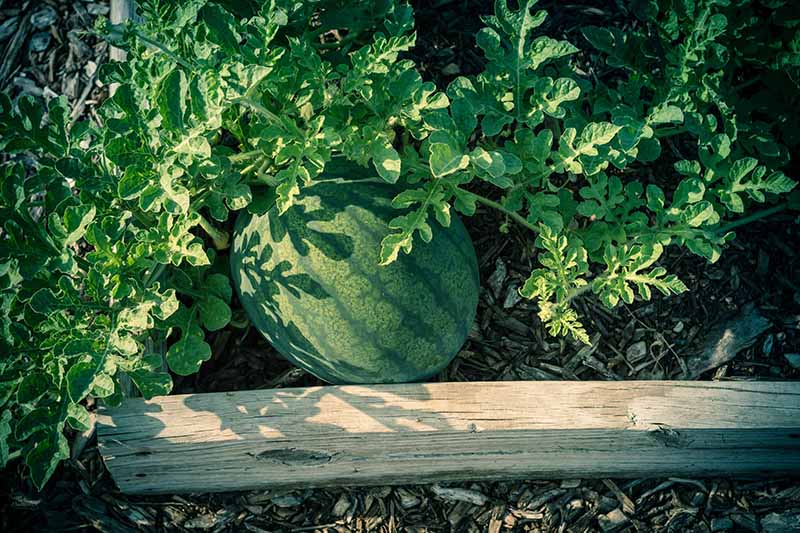
Another advantage to icebox types is that they tend to mature earlier than most picnic cultivars, so these are generally better choices for gardeners with a shorter growing season.
Or they can be grown alongside picnic varieties by gardeners who want to make sure they have an earlier crop to enjoy, as well as an abundance of fruit throughout the season.
Some of them also make better candidates for growing in raised beds since their vines can be (but aren’t always) shorter than those of picnic varieties.
7. Blacktail Mountain
If your climate tends to feel like an icebox at night, even in midsummer, ‘Blacktail Mountain’ may be your answer if you want to grow watermelons.
Developed in Northern Idaho, this is a short season open-pollinated cultivar that will tolerate cool nighttime temperatures.
‘Blacktail Mountain’ produces fruit that weigh six to 15 pounds, just the right size for storing in your fridge. Fruits are round with a dark green rind and sweet scarlet-hued flesh.
And if your first frost comes early, fruits can be picked a little before full ripeness and ripened in storage, where they can keep for up to two months.
Wonderful for northern areas with cool nights and short growing seasons, this variety comes to maturity in just 70-75 days.
You’ll find certified organic and biodynamic ‘Blacktail Mountain’ seeds available for purchase in one-gram packets from Territorial Seeds via Arbico Organics.
8. Bush Sugar Baby
Looking for a bush type watermelon that’s perfect for smaller gardens – or even for growing in containers?
We’ve got you covered. ‘Bush Sugar Baby’ produces an average of two 12-pound melons per plant, on “space-saving” vines.
This icebox type is small enough to store in the fridge, producing round dark green fruit with sweet scarlet flesh.
Plants grow to a height of 15-24 inches, with vines growing to be 3 1/2 feet long. This variety has good resistance to cool weather, cracking, drought, and sunburn.
‘Bush Sugar Baby’ will be ready to harvest in around 80 days.
This space-saving icebox variety is available in packets of 40 seeds from Burpee.
9. Sweet Beauty
‘Sweet Beauty’ is a hybrid variety with superior eating quality that was the All-America Selections winner in 2004.
A smaller icebox variety, these fruits weigh in at six to seven pounds.
Small oblong watermelons are striped with dark and light green. Flesh is deep red with a sweet flavor and crisp texture.
The vines on this variety will spread eight to 10 feet and bear harvestable fruit in just 77-80 days.
You’ll find ‘Sweet Beauty’ seeds available for purchase in a choice of package sizes at True Leaf Market.
Personal
If you love watermelon but really wish you could harvest single-serving fruits, then personal type melons are going to make your day.
These cultivars weigh between three to six pounds, and are a delight to cut in half and eat with a spoon in one sitting.
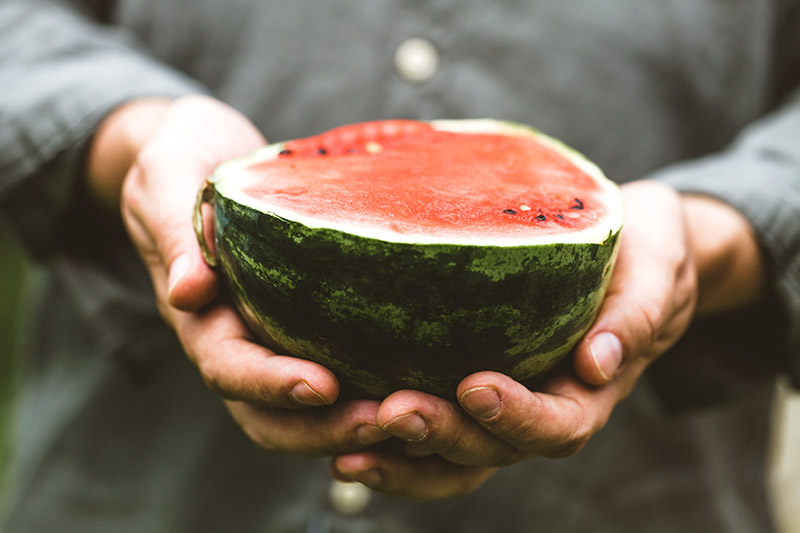
Personal type watermelons are also a boon for those of us with short seasons and a risk of early frosts – they are the earliest to ripen.
And for those with long summer growing seasons or gardeners in warmer regions who have gotten their garden off to a late start, they will make a delicious early summer treat while you wait for your big picnic cultivars to ripen, or a juicy delight to enjoy come Labor Day.
10. Golden Midget
‘Golden Midget’ is a personal-sized watermelon variety that will really stand out in your melon patch – literally.
The rinds of this open-pollinated cultivar turn gold when ripe, making harvesting a snap.
Round fruits are tiny, at just three pounds each, and they contain sweet pink-colored flesh with dark seeds.
‘Golden Midget’ is a super early variety that’s great for short-season growers – fruit will be ready to harvest in just 70 days.
You’ll find ‘Golden Midget’ available for purchase in an assortment of packet sizes at Eden Brothers.
11. Little Darling
‘Little Darling’ is a small, early maturing hybrid watermelon variety that bears oblong, five to seven-pound fruit with dark green rinds.
These personal-sized fruits have a high sugar content, which means their red flesh is super sweet.
The vines of this early-maturing cultivar are compact at four to five feet long, producing melons that are ready to harvest in 65-70 days. Expect three to four fruits per plant.
You’ll find ‘Little Darling’ seeds available for purchase in packs of 30 at Burpee.
12. Mini Love
‘Mini Love’ is a high-yielding and compact hybrid that produces single-serving-sized round watermelons.
This variety was the All-America Selections winner in the edible category in 2017, winning for both its crack resistant rinds and its delectable flavor.
Fruits weigh in at three to six pounds, with about six fruits per plant.
The flesh of this cultivar is deep red and has a high sugar content, making for a delicious and juicy personal-sized treat.

The vines of ‘Mini Love’ are compact at three to four feet long, making this cultivar an excellent option for growing in small spaces and containers. These plants have good resistance to anthracnose.
Fruits have thin but strong rinds, giving them good resistance to cracking and splitting.
This early maturing variety will be ready to harvest in around 70 days.
You’ll find ‘Mini Love’ seeds available for purchase in packs of approximately 18 each from Park Seeds via Amazon.
Giant
Most of us have heard of gardeners growing giant pumpkins, but giant watermelons aren’t quite as common. I guess we have been missing out on this branch of competitive gardening – at least I have!
According to Guinness World Records, the largest watermelon ever grown weighed in at just over 350 pounds!
You don’t have to get quite that big for your melon to be considered a giant though. Giant cultivars include those that weigh at least 32 pounds at full ripeness.
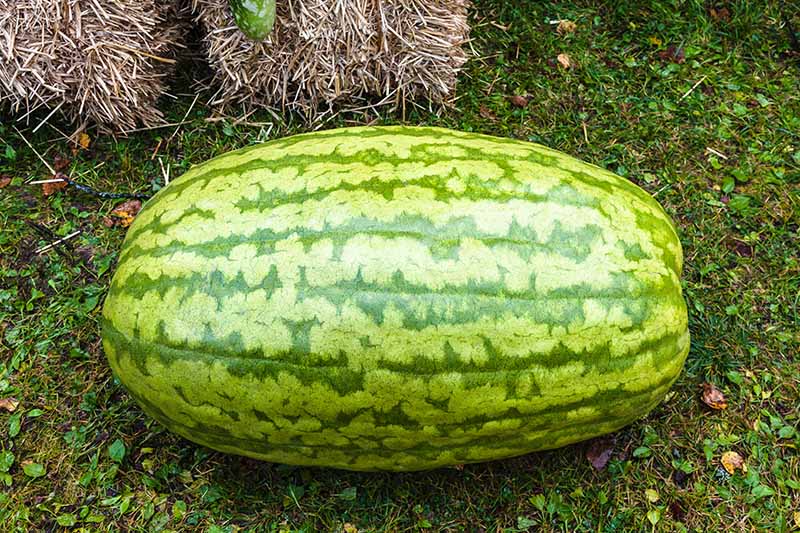
Keep in mind that you will certainly need a generous growing season in order for your watermelons to grow to such mammoth proportions.
And psst, there’s a trick to getting such huge melons. If you’re going for whoppers, you’ll want to whittle down an excess of baby melons to allow the plants to focus their energies on just a couple.
13. Black Diamond Yellow Belly
‘Black Diamond Yellow Belly’ is a high yielding, open-pollinated heirloom variety that produces slightly oblong fruit, with dark blue-black rinds that are bright yellow where the melons touch the ground.
Fruits have rich red flesh with an excellent texture.
They are generally 25-35 pounds but with enough available growing days and attentive care, these can weigh in at a whopping 75 pounds.
Also known as ‘Yellow Belly Black Diamond’ and ‘Superior Black Diamond,’ this cultivar’s thick rinds make for excellent storage.
Plants have large leaves, protecting the fruits from sunburn. When the bellies of these melons turn bright yellow, that’s when you’ll know they’re ripe.
‘Black Diamond Yellow Belly’ will be ready to harvest in around 90 days.
You’ll find seeds available for purchase in a selection of package sizes at Eden Brothers.
14. Carolina Cross #183
‘Carolina Cross #183’ is truly a giant, with some growers producing gigantic watermelons weighing over 200 pounds at harvest.
You read that right – the range described on seed packets for these is 50-200 pounds, so enormous yields aren’t all that unusual, under the right conditions. One reviewer on the Burpee website said they are “so big that people stop and ask questions.”
And these heirlooms are not just for show – when grown to full maturity, the red flesh inside is delicious, too.
Oblong in shape, ‘Carolina Cross #183’ has a light green rind with narrow dark green stripes.
Plants reach a height of 15-24 inches with a spread of 96-120 inches. They grow quickly, requiring about 100 days to harvest.
If you’re ready to grow this giant, packets of 25 open-pollinated seeds are available from Burpee.
15. Florida Giant
‘Florida Giant’ produces round fruit that generally reach 30-40 pounds but can max out at 50 pounds in the right conditions.
Introduced in the 1940s, this heirloom open-pollinated variety has a dark green rind and tasty red flesh.
For watermelons that are at their sweetest, make sure to let them ripen fully – for this variety, count on about 90 days until harvest.
You’ll find ‘Florida Giant’ available for purchase in an assortment of seed packet sizes at Eden Brothers.
Seedless
Are you a fan of seedless watermelon?
Personally, I don’t mind seeds in my melons, but the seedless types do have a very useful purpose beyond the desire for a seedless slice.
When you’re using this fruit for culinary creations, such as sorbets or salads, seedless fruits are much more convenient than the seeded types since you get to skip the tedious step of removing those tiny pips from the flesh.
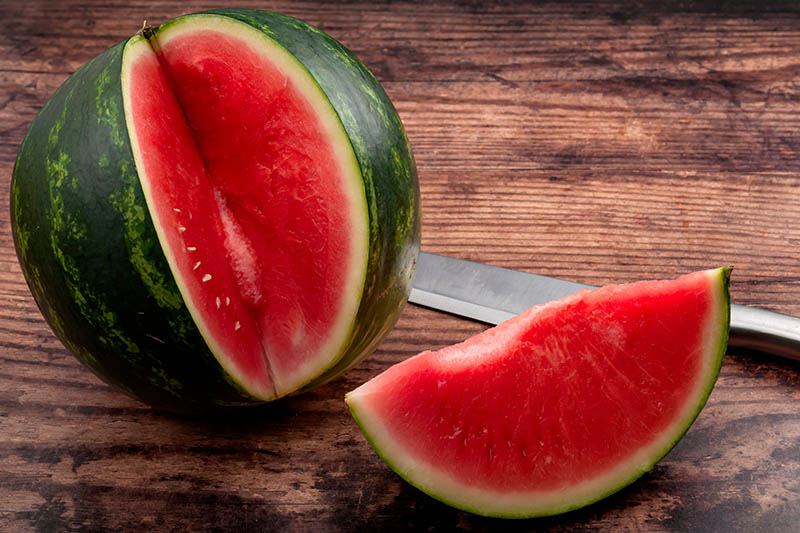
Growing these hybrids at home is doable, but it requires a bit more work and is a bit trickier than growing seeded types.
To start with, seedless varieties have a lower germination rate and because of this, they are often started as transplants instead of direct sowing.
In addition to lower chances of successful germination, seedless varieties must be planted with a pollinator plant (i.e. a seeded watermelon) nearby in order for seedless plants to produce fruit.
And this pollinator variety needs to bloom at the same time as the seedless cultivar.
So it’s a little extra work, but by no means a daunting gardening project.
If you’re the type of gardener who’s up for a bit of a challenge – and most importantly, one who prefers seedless watermelon – give it a try!
16. Big Tasty
This seedless hybrid offers big flavor in a tiny package.
Topping out at six to eight pounds each, ‘Big Tasty’ melons reach about 10-12 inches in diameter when they’re ready for harvest.
Fruits are round or oval shaped with pale gray-green skins that hold crisp, firm, bright red flesh with stunning flavor.
In fact, this variety won Burpee’s taste test when compared to over 50 other varieties.
This watermelon cultivar is known to keep its delicious flavor longer than other types after you cut into it, so it’s perfect for those with small households who know they might not be able to eat a whole melon all at once.
As a seedless variety, ‘Big Tasty’ will need to be planted with a seeded pollinator cultivar, such as ‘Gold in Gold.’
Plants reach a height of 15-24 inches with a spread of 60-72 inches. Expect a harvest in 85 days.
‘Big Tasty’ is available in packs of 12 seeds from Burpee.
17. Mini Piccolo
‘Mini Piccolo’ is a seedless hybrid variety that comes in a single-serving size. Round fruits have green rinds with darker green striping and weigh a diminutive two to four pounds.
These personal-sized watermelons have dense red flesh and are super sweet.
Plants are vigorous, producing up to six fruits each, and growing 14 inches tall with a 10-foot spread. Make sure to plant ‘Mini Piccolo’ with a seeded pollinator variety, such as ‘Crimson Sweet.’
These melons will be ready to harvest in 80-83 days.
You’ll find ‘Mini Piccolo’ available for purchase in packs of 20 seeds at Burpee.
18. Triple Crown
‘Triple Crown’ bears large picnic-sized watermelons. The “triple” in this cultivar’s name refers to the fact that it is a triploid, or in other words, a seedless hybrid.
Fruits weigh 18-20 pounds and are oval shaped, with light green rinds and dark green stripes. The fruits of this variety have deep red, juicy, firm flesh with a fine-grained texture.
Don’t forget that this seedless type will need to be grown with a pollinator variety. ‘Bush Sugar Baby’ makes a good pollinator for ‘Triple Crown.’
High yielding plants will produce fruit that’s ready to harvest in 80 days.
You’ll find ‘Triple Crown’ seeds available for purchase in packs of 10 at Eden Brothers.
Orange, Yellow, and White Flesh
Like me, you may have only eaten bright red or luscious pink watermelon growing up. But these fruits can also produce flesh in shades of white, yellow, or bright orange.
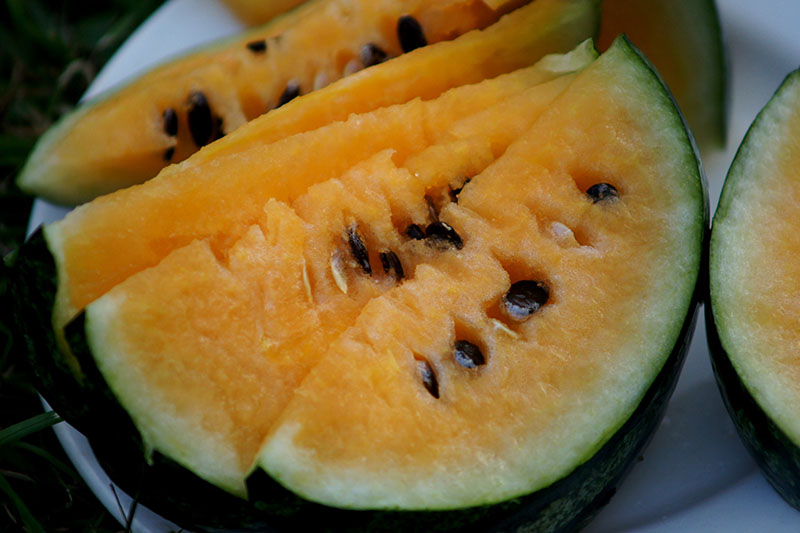
If you’re the adventurous type and love growing unique garden fruits and veggies in all colors of the rainbow, you might want to try one of these colorful cultivars.
19. Orange Crisp
This orange-fleshed picnic variety offers an added bonus if you’re not up for spitting or picking out pips. ‘Orange Crisp’ is a hybrid watermelon that has sweet, crisp, deep orange flesh unmarred by pesky seeds.
Fruits are 11 inches in diameter, weigh 17-19 pounds when ripe, and are round to oval shaped. ‘Orange Crisp’ has a thick rind that’s light green with darker green stripes, and holds in storage very well.

Plants produce heavy yields of fruits that are resistant to sunburn and hollow heart.
Don’t forget to plant seedless ‘Orange Crisp’ with a seeded pollinator cultivar, such as ‘Charleston Gray.’
Expect a harvest of these orange-fleshed beauties in about 87 days.
You’ll find ‘Orange Crisp’ available for purchase in packs of 25 seeds from Park Seeds via Amazon.
20. Orangeglo
‘Orangeglo’ has the crisp and refreshing mouthfeel of a regular watermelon – but its orange flesh has a surprising, somewhat tropical taste.
The flesh of this open-pollinated variety is simply stunning – it’s bright orange in color and sugary sweet with hints of exotic fruit flavors.
‘Orangeglo’ has unusual seeds as well – they are beige with two brown dots at the tips.
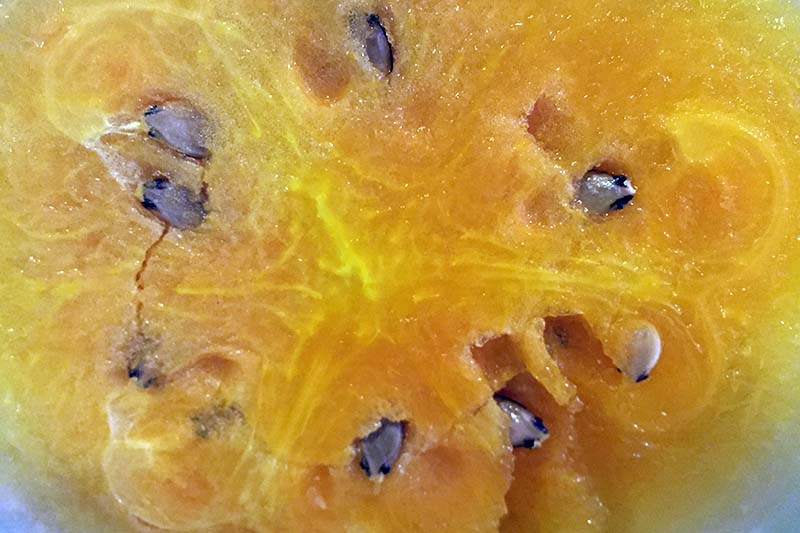
Fruits are oblong, light green with green striping, and top out at 20-30 pounds when ripe. Rinds are fairly thin – slice a knife into one of these melons and it will crack open with little effort.
This picnic variety was developed by the Willhite Seed Company in Poolville, Texas in the 1960s, but despite its Southern origins, it does well in northern climates and is cold tolerant.

Plants produce heavy yields and have good resistance to wilt and insect pests. Fruits are resistant to splitting on the vine.
You’ll be harvesting ‘Orangeglo’ in 90-100 days.
‘Orangeglo’ is available for purchase in packs of 20 seeds from David’s Garden Seeds at Amazon.
21. Orange Tendersweet
‘Orange Tendersweet’ (or ‘Tendersweet Orange,’ depending on who you ask) is sure to be a favorite, with its attractive oblong shape and bright orange flesh.
Also called ‘Orange Flesh Tendersweet,’ this heirloom variety is in fact very sweet, and fruit will weigh 30-50 pounds at full ripeness.
And since it’s open-pollinated, you could try saving your own seeds to grow next year.
Rinds are sturdy, and striped with dark and light green. The bright orange flesh of this melon is sweet and tasty with a tender texture.
Plants reach a height of 15-24 inches with a spread of 72-96 inches, and produce harvestable fruit in 90 days.
Seeds are available for ‘Orange Tendersweet’ in an array of package sizes at Eden Brothers.
22. Gold in Gold
‘Gold in Gold’ is an early maturing yellow-fleshed hybrid variety that was the All-America Selections winner for 2017.
These icebox sized watermelons are sure to surprise you – not only do they have gold flesh, they also come dressed in a two-toned yellow and gold rind.
They don’t just look delicious, though – their flavor is also a thrill. These melons have a high sugar content and their sweet golden flesh has a pleasantly crisp texture.
Fruits are oval shaped and weigh 11-16 pounds when ripe, so they fit nicely in the fridge.
Plants grow to 20 inches high with vines that spread up to 10 feet. ‘Gold in Gold’ has good general disease resistance, and thin but strong rinds that resist cracking.
You’ll be ready to harvest these golden fruits in 80-84 days.
‘Gold in Gold’ is available for purchase in 20-seed packages at Burpee.
23. Mountain Sweet Yellow
‘Mountain Sweet Yellow’ is an open-pollinated, yellow-fleshed heirloom variety that was developed from ‘Mountain Sweet,’ a red fleshed cultivar grown in the Northeast in the 1800s.
These oblong picnic-style watermelons reach 20-35 pounds at full ripeness. Rinds are dark green with light green stripes, and the flesh is deep yellow with black seeds.
‘Mountain Sweet Yellow’ has a high sugar content that will have you coming back for more of its juicy, firm, sweet yellow flesh.
Vines will spread to six to 10 feet, with fruit that’s ready to harvest in 95-100 days.
You’ll find ‘Mountain Sweet Yellow’ seeds available for purchase by the gram from Botanical Interests.
24. Yellow Petite
‘Yellow Petite’ is an early maturing icebox watermelon with sweet yellow flesh that is nearly seedless.
Also known as ‘Petite Yellow,’ fruits reach six to 10 pounds, and have light green rinds with dark green stripes.
The rinds on these round fruits resist cracking, making them easy to transport to picnics or family reunions.
The leaves on these open-pollinated plants will cover the fruits, helping to protect them from sunburn.
Expect fruits to be ready for harvest in 65-85 days.
You’ll find ‘Yellow Petite’ seeds available for purchase in an array of package sizes at Eden Brothers.
25. Cream of Saskatchewan
‘Cream of Saskatchewan’ is a rare white-fleshed heirloom watermelon that was developed in Ukraine. Thanks to its heritage, this variety does well in northern climates.
Small round melons reach four to 10 pounds – or more, in warmer climates – with thin rinds that are light green with dark green stripes.
And you’ll love the sugary sweet cream-colored flesh.

Plants grow six to 12 inches tall with eight to 10-foot-long vines. They stand up well to cool weather, and will be ready to harvest in 75-85 days.
You’ll find ‘Cream of Saskatchewan’ available for purchase in packs of 20 seeds at Amazon.
A Rainbow of Juicy Selections
Red ones, pink ones, yellow ones, orange ones, white ones – we’ve nearly covered the rainbow with these watermelon options.
I don’t know about you, but I’d happily accept the challenge of gobbling up a slice of each of these 25 watermelon cultivars right now.

Which one whets your appetite? Have you discovered any varieties among this selection that you think would be perfect for your garden?
Do you have any other favorites that we didn’t include here? Please let us know in the comments!
If you need a reminder on best practices for growing these glorious fruits, make sure to check out our complete guide to growing watermelons.
Now that you have some solid watermelon options, are you ready to grow all the fixins’ for your next summer picnic? Visit our veggie growing guides for inspiration.
And you can learn more about growing melons in your garden right here:
© Ask the Experts, LLC. ALL RIGHTS RESERVED. See our TOS for more details. Product photos via Amazon, Arbico Organics, Botanical Interests, Burpee, David’s Garden Seeds, Eden Brothers, Hirt’s Seeds, Park Seed, and True Leaf Market. Uncredited photos: Shutterstock. With additional writing and editing by Allison Sidhu.
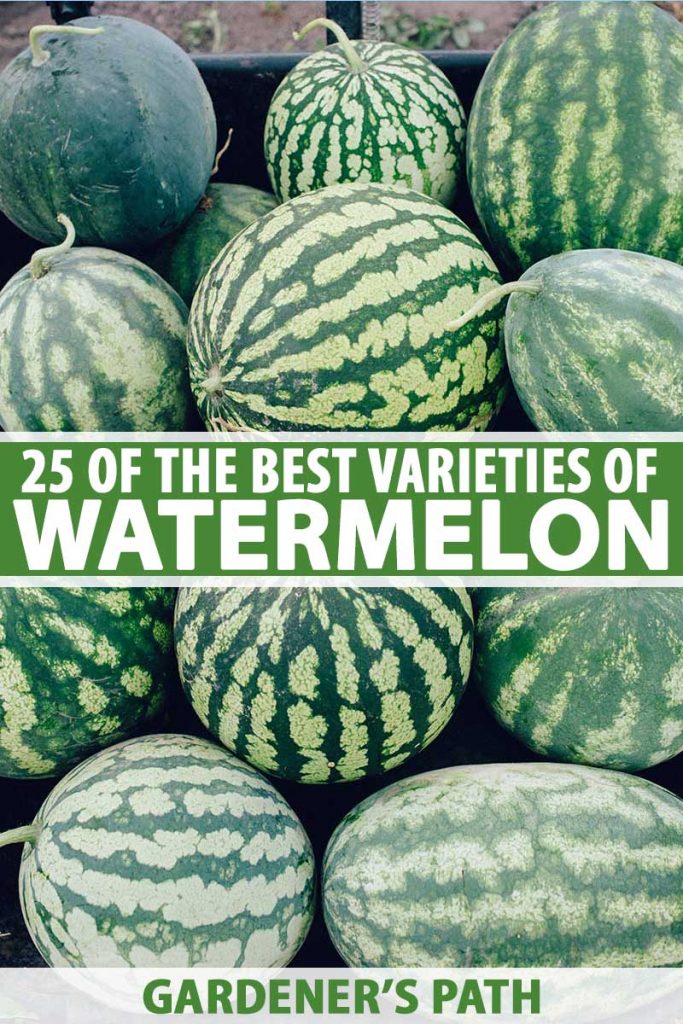
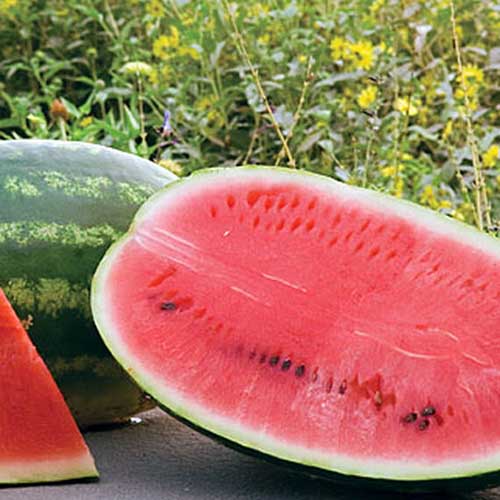
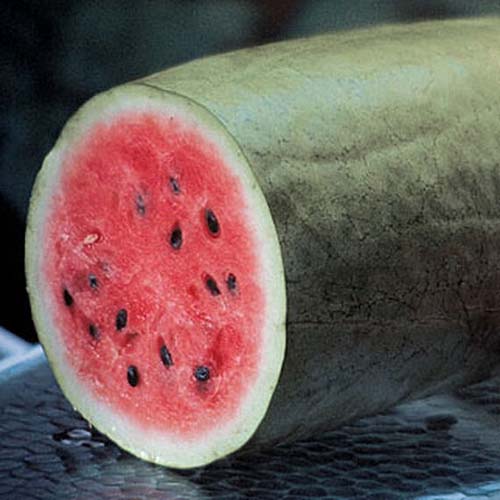
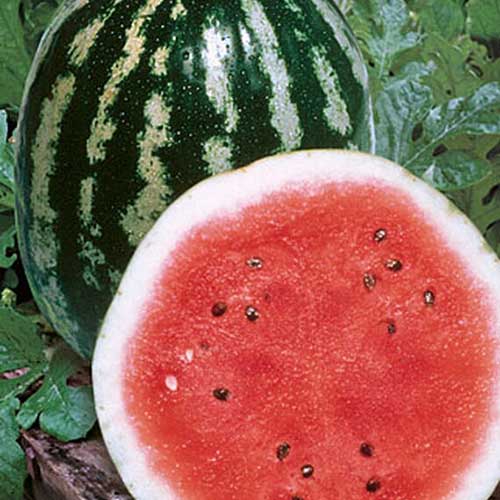
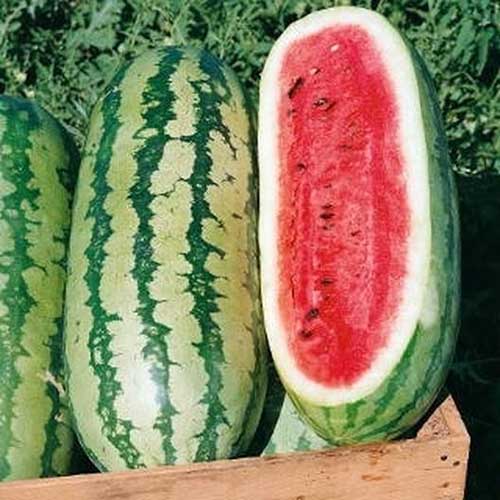
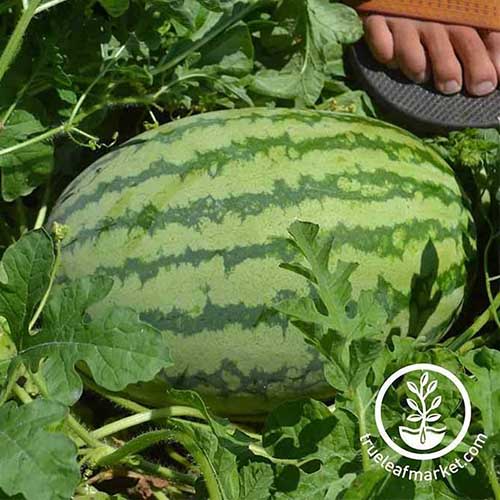
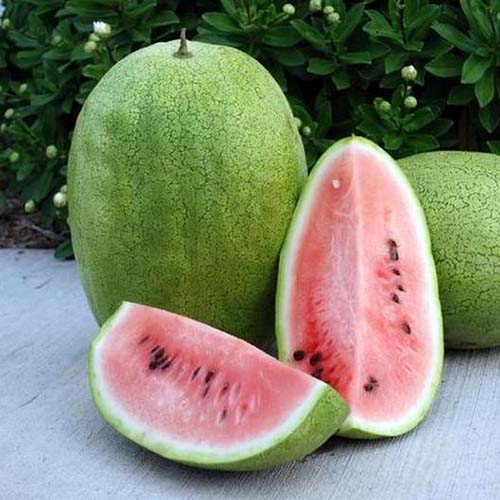


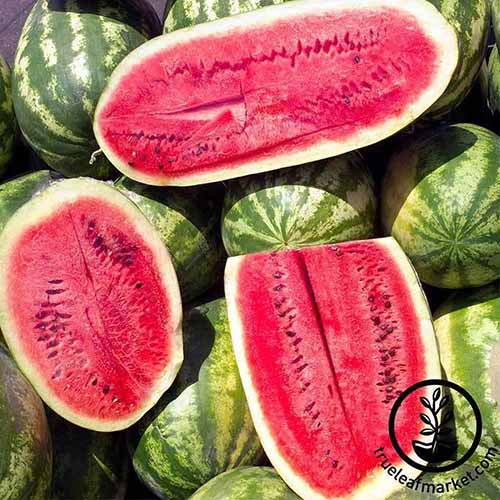


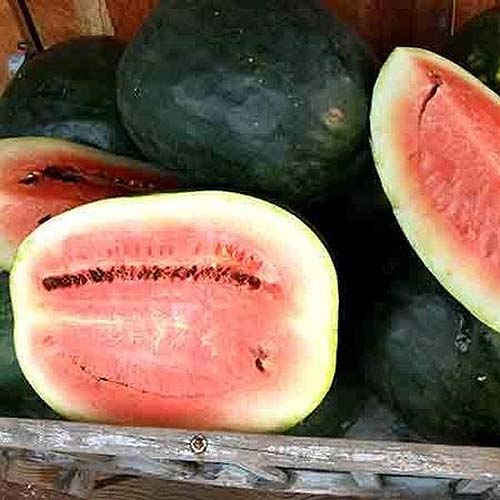
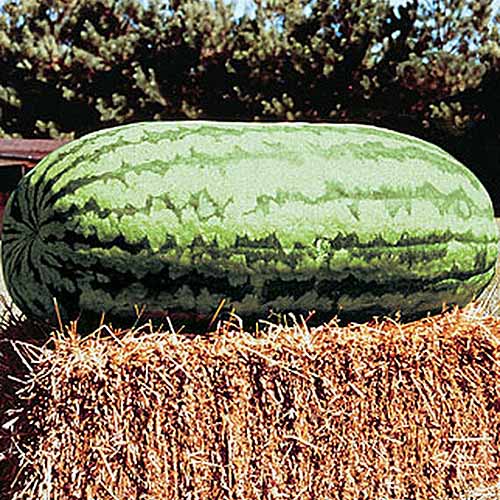
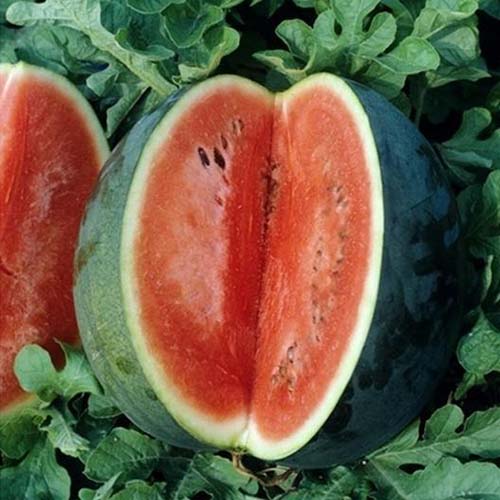
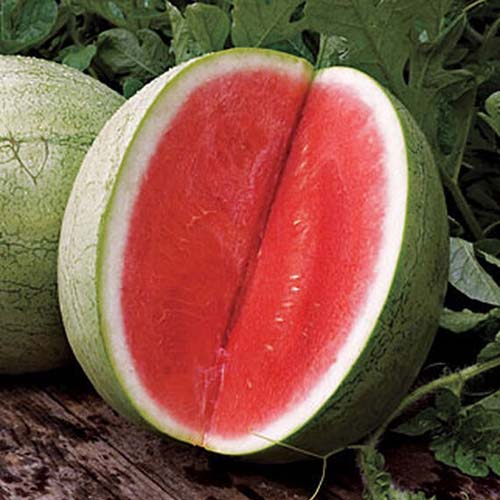
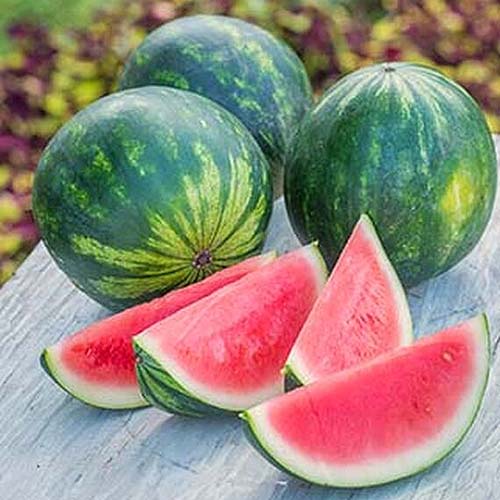
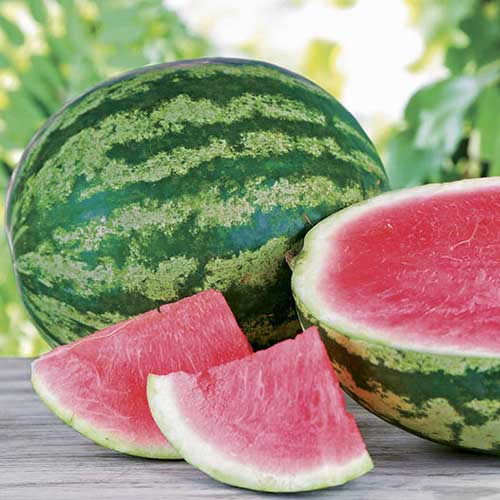
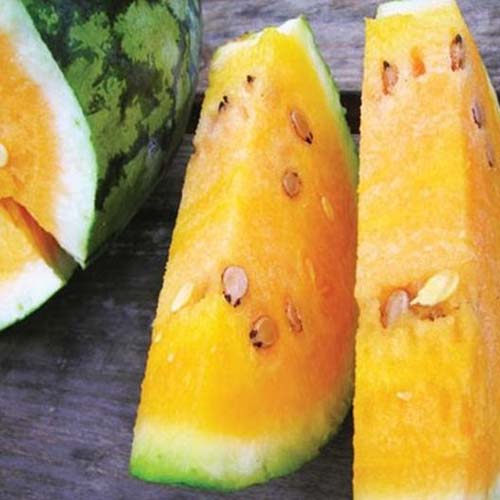
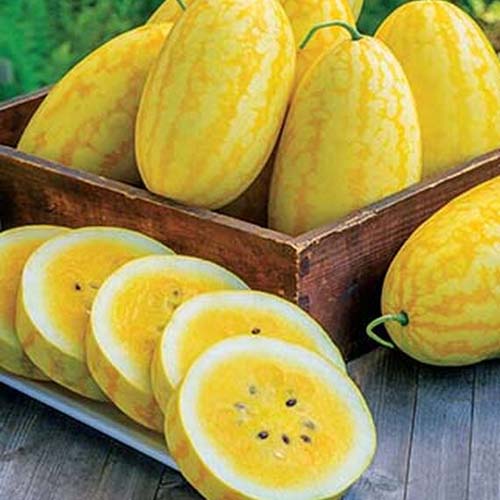
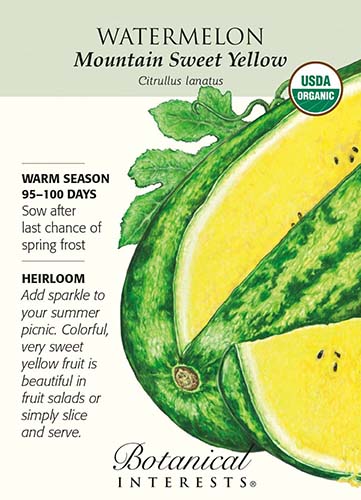
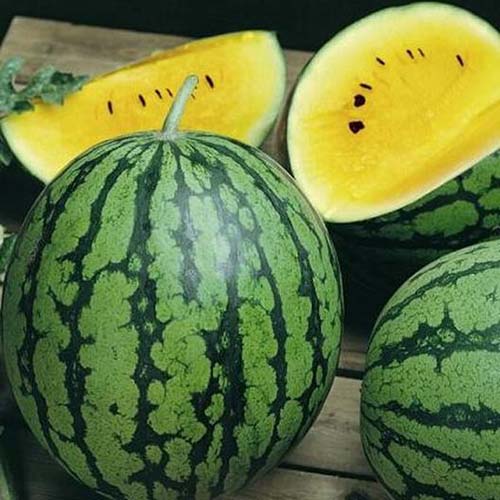
what do you know about Cave City Sultan watermelons? Always thought the best ever,
Hi Albert, So there seem to be two parts to your experience with those watermelons. The first would be the cultivar, ‘Sultan,’ which isn’t a very widely sold variety and I haven’t tried it myself. If you’d like to try to find seeds from these watermelons, looking on a seed exchange forum would probably be your best bet. The second part is the Cave City part. Cave City, Arkansas is known for its sweet watermelons. It seems this is due not to a particular cultivar, but rather the excellent growing conditions they have there in that part of Arkansas. The… Read more »
Tqvm Kristina, great info on watermelon varieties. Newbie here, will try plant some fresh seeds I just eaten… haha. Maybe will try source online if any great seeds available. Bored lockdown at home, Malaysia… haha. Thanks !
Hi Sean, Thanks for your message! Gardening is certainly a wonderful hobby when we’re stuck at home. Just so you know, if you plant the seeds from your store bought watermelon, they might work out for you, but they might not. It can be a gamble planting seeds from produce that was purchased, because we don’t usually know the variety or if the plants were grown in isolation from other varieties. In other words – if you get fruit from your plants, they might not be like the ones you just ate. However it can certainly be fun to just… Read more »
I am dealing with Fusarium wilt as of late. The only watermelons I had good luck with this year were AU Producer and LeeLanau SweetGlo. The AU Producers were 22-26 pounds wit a Brix ox of 10.2-11.0. Can’t seem to find many orange or yellow varieties anymore that can handle the Fusarium Wilt. Any suggestions?
Hi Mike, You’re right, there’s aren’t as many orange or yellow varieties that are resistant to Fusarium wilt. I did some digging, though, and found a few more you might want to consider, including some that are tolerant of Fusarium wilt (not as good as resistant, but just in case you’re interested). I added brix scores when available. Resistant to fusarium wilt: Butterball – yellow flesh – brix 9.8 Yellow rose – yellow-orange flesh Tolerant of fusarium wilt: Gold Strike – orange flesh Sunny – yellow flesh Sunshine – yellow flesh – brix 10.4-11.8 Super Gold – yellow flesh –… Read more »
Thank you For your help. I did forget that I had good luck with Sangria which is a red. Gold Strike was 1 of the orange varieties I had good luck with up until this year. I thought about grafting with Bird House bottle neck gourd root stock as I also grew them for the fun of it this year. I have never grown any watermelon in my raised beds which have a different soil mixture. Might be worth a try. My Agronomic and Agricultural Science background make me think that it might work. Thanks Again
There are definitely more red-fleshed varieties that are resistant to Fusarium wilt, so if you are open to those types you’ll find much more of a selection. A few of them in this article have good resistance to that disease.
Best of luck to you!
Very well done article. I was looking at your list after putting in my seeds in South Florida zone 10 and the first thing I noticed was no mention of Gold Strike, which is a shame. That watermelon is my favorite, hand down and the best for Southwest Fl IMHO. It stays much more crisp then Orangeglo with a much higher yield potential and without the concern for the splitting issues that Orangeglo has. Unfortunately, I cannot find seed for Gold Strike and it seems like they may have discontinued it for it has been 3 years at least since… Read more »
Hi Chuck, I’m glad you enjoyed the article – thanks for letting us know! It does seem impossible to find ‘Gold Strike’ seeds at the moment for some reason. You might have luck finding it from a community of seed savers (perhaps locally) that would be willing to trade or sell the seeds to you. And fingers crossed that some smart seed vendors get this variety back on the market. In the meantime, our readers will appreciate knowing that this is a good cultivar for Southwest Florida, so thanks for sharing your experience with it. Feel free to let us… Read more »
Gold Strike is a hybrid variety Kristina so not possible. If it were open pollinated, I would never have been without. I see people mentioning this watermelon as being orange, but it is not orange, it is a nice Gold color, hence its name.
Thanks for your input, Chuck!
Hello there , my name is Abulgasim I’m from sudan ????????(north africa) i would like to thank you for the amazing article , the most popular type of watermelons here is the crimson one .
in north Africa and the middle east melon seeds are so popular among the people, ,they mostly come from Egypt/sudan ,
as you can see in these pictures there are small melons , what’s the name of this type, and is it famous in the west ?
Hi Abulgasim, Thanks for your comment and question. In the US, red-fleshed watermelons are the most popular, with white-fleshed types being sort of a novelty that adventurous home gardeners might enjoy growing. Apparently white-seeded watermelons are much more popular in China and the Middle East, and since they are so uncommon here in the US, I’m not able to identify the variety or varieties in the photos you shared. If you want to pursue your quest to identify those varieties, I think I would contact the source that originally posted the photos – perhaps they would be able to tell… Read more »
How is the Bradford Watermelon not even on this list? It’s literally the best of all of them.
Hi Ronny,
Sounds like the Bradford is probably more well-known in South Carolina, where it hails from. I will have to get my hands on some seeds and give them a try. Thanks for bringing this cultivar to our attention!
Anybody ever heard of a Mountain Heuser? My pappa used to grow them, but I was trying to look for a picture of one
Hi Joe,
Are you thinking of ‘Mountain Hoosier’? Apparently these are large watermelons with dark green rinds, deep red flesh, and large white seeds. Does that sound like the one you’re looking for? I don’t have any photos, but perhaps this will set you on the right track. Let us know!
Hi Kristena which watermelon verity is best for farming and selling best please answer me
Hi Abhi,
The best watermelon variety for this purpose will depend on many factors – most importantly, the length of your growing season, any disease considerations in your area. Of course, then you’ll want to pick the type you want to grow – big or small, red flesh, yellow flesh, white flesh, or orange flesh. I recommend you speak to other farmers in your area and learn from their experiences.
Best of luck!